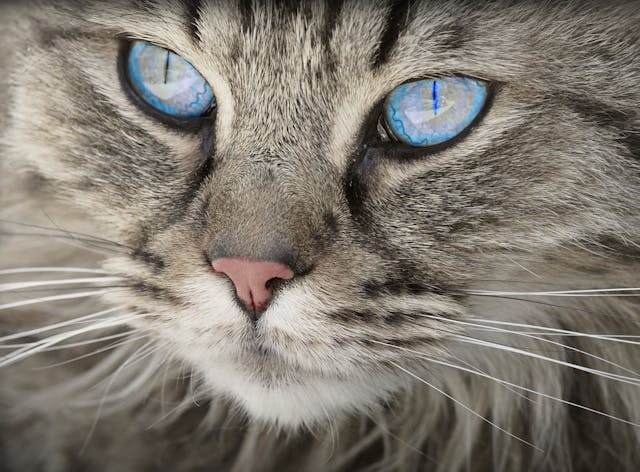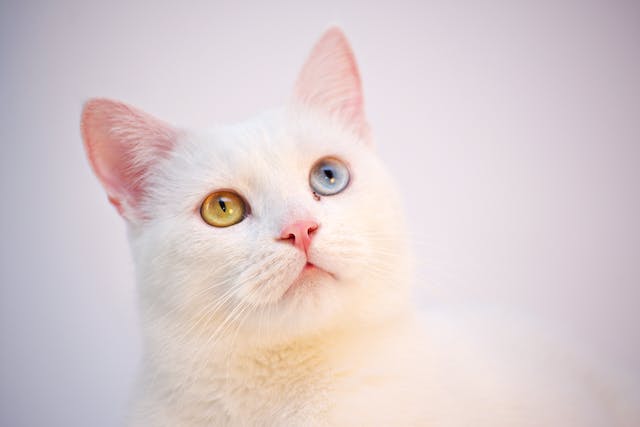What Colors Can Cats See?
Posted: 04/09/2024 | BY: Jenna Bruce | Categories: Cat , Health problems , Top Tips
When you’re interacting with your cat, do you ever wonder how they see the world? We know cats can see very well in the dark. This helps them to hunt in the wild and run around your house like a lunatic at 3 in the morning. But what about colors? What colors can cats see?
You may be surprised to learn that how cats see color is a topic that has been well-researched over the years. And the results of this research may surprise you. While our feline friends cannot see all of the colors that we humans do, it turns out their world is pretty colorful as well!

How Do Eyes See Color?
There are special nerve cells in the eye that allow colors to be discerned. Within the retina there are two main types of cells called rods and cones. It is the cones, which are very specialized and sensitive cells, that can determine the presence of color.
Both human and feline eyes have three types of cones that can identify combinations of the colors blue, red, and green. The reason humans can see more color variations than cats is because we have 10 times more cones than they have. But this doesn’t mean cats don’t see color at all. They do, but it is believed that they may not see the “true” color of an object. Also, because of how their eyes work, cats might not experience the full range of colors we do. They likely see blues and yellows best, with reds and greens appearing as shades of gray. This is like having red-green color blindness in humans.
There are other differences in human vision and cat vision. For instance, in some ways, cat vision is not as accurate as human vision. Cats are more near-sighted than we are. So let’s say you and your cat are both standing 100 feet away from an object, you would see the object very crisp and clearly (provided you have good eyesight or are wearing your glasses), while your cat’s vision of the object would be blurred. In fact, the object would not appear crips and focused to your cat until it got about 20 feet away from it.
The Feline Visual Advantages
Okay, so your cat can’t see all of the colors in the world and they can’t see objects well at a distance. But nature has given them some pretty great visual advantages to compensate.
As an example, cats’ eyes are set more on the side of their head. This allows them to have a broader range of peripheral vision than we have. These wide set eyes may not provide the same depth perception we have, but that peripheral vision sure helps them hunt and watch for danger.
In addition, cats have elliptical pupils that dilate maximally. This allows cat eyes to capture as much light as possible, which is why they can see far better than we can in the dark. They also have reflective cells under the retina, which gives them an even bigger advantage in the dark.
Our feline friends also have more rod cells in the retina than we do. This helps them to detect motion far better and quicker than we ever could.
Common Cat eye Ailments
Now that we know a bit more about how your cat’s eyes work, let’s end by discussing some of the most common cat eye ailments, so you can keep your fur baby’s eyes healthy!
Pink Eye (conjunctivitis)
Just like people, our cats can also get pink eye. Symptoms include a pink or reddish color, pasty eye discharge, and swelling.
There are a variety causes of pink eye, with the most common being a bacterial infection, a virus such as feline herpesvirus, or an allergen. Pink eye can be very painful and can worsen if not treated. If you see signs, take your fur baby in to get checked by your vet.

Corneal Damage
There are numerous ways your cat can damage their cornea. Sometimes cats accidentally scratch their own cornea when scratching their head. Being ever curious creatures, it’s very easy for them to get a bit of dirt or debris in there. And if they have any aggressive playtime with another cat or pup in the house, their cornea can also become scratched.
Corneal damage results in red and tearing eyes. You may even see some blood, depending on the severity of the damage. Your cat might also be squinting and pawing at their face a lot. If you suspect their eye has sustained some damage, bring them in to the vet ASAP.
Entropion
Another condition that can result in a damaged cornea is called Entropion. This is when the cat’s eyelid folds inward, allowing the eyelashes to rub against the cornea. Breed-related facial features, common in Persian, Himalayan, and Burmese cats, can cause inherited entropion. Symptoms of Entropion include excessive tearing, squinting, redness, or sagging skin around the eyes.

Keep Your Cat Healthy and Happy with a Pet Insurance Plan
Your cat is precious from head to toe, so it’s important you can keep them healthy from head to toe. But sometimes, a serious injury and illness can occur that completely catches you off guard, and potentially puts you in debt.
Take care of your fur baby and your savings account at the same time by purchasing a pet insurance plan. Plans can range between just $11 and $30 a month, with some plans reimbursing you for up to 90% of the cost of care.
If you’ve been putting off pet insurance because you didn’t know where to start, here are the top pet insurance providers – in order – based on over 150,000 authentic reviews from pet parents just like you:
Top Pet Insurance Providers of 2025
Rating Provider Total Review 4.9 Embrace 20,325 4.9 Healthy Paws 10,780 4.9 Fetch 27,472 4.9 Pets Best 14,160 4.8 Lemonade 815 4.8 Nationwide 21,417 4.8 Trupanion 63,001 4.8 Prudent Pet 2,481 4.7 Pumpkin 2,588 4.6 ManyPets 2,428 4.6 MetLife 6,069 4.6 Spot 9,942 4.5 ASPCA 12,062 4.5 Hartville 177 4.4 AKC 895 4.4 PetPartners 117 4.1 Figo 2,791 3.9 Pet Assure 15
References:
- https://vcahospitals.com/know-your-pet/do-cats-see-color
- https://www.thewildest.com/cat-lifestyle/what-colors-do-cats-see
- https://www.aspcapetinsurance.com/resources/top-eye-problems-for-cats/
Disclaimer
The information contained on this blog is intended for informational and educational purposes only and should not be construed as medical advice. It is not a substitute for professional veterinary care. Always consult with your veterinarian before making any changes to your pet's health care or treatment plan.
The authors of this blog are not veterinarians and do not claim to be experts in pet health. The information provided here is based on our own experiences and research, as well as information from reputable sources. However, we cannot guarantee the accuracy or completeness of this information.
We encourage you to do your own research and consult with your veterinarian before making any decisions about your pet's health.
Previous post
How Do Cats Get Worms?Next post
Solensia For Cats: Does it Really Work?Compare top pet insurance providers plans.
Enter your dog’s age in years and months to calculate their age equivalent to human years.
Calculate your dog’s ageEnter your cat’s age in years and months to calculate their age equivalent to human years.
Calculate your cat’s age